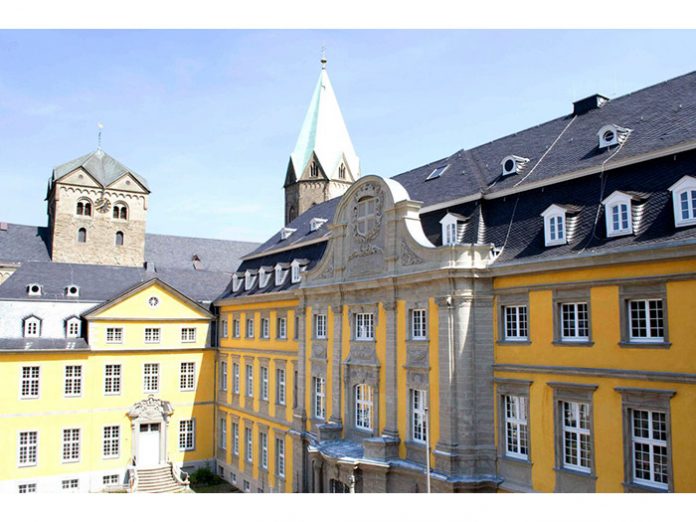Astro Spatial Audio is now introducing students at Germany’s prestigious Folkwang University of the Arts to the transformative potential of true object-based audio, courtesy of a recently completed installation with the SARA II Premium Rendering Engine at its heart.
Folkwang Universität der Künste has enjoyed a close connection with the worlds of electronic and experimental composition since the early 1970s, leading to the inception of the Institute for Computer Music and Electronic Media (ICEM) in 1989. A multi-purpose electronic studio and facility, comprising recording spaces and performance areas, the ICEM’s professors and staff have consistently sought to remain one step ahead of the technological curve in terms of the equipment made available to students.
Now those students can experience the power and flexibility of true object-based audio courtesy of Astro Spatial Audio’s SARA II Premium Rendering Engine, using the system to create immersive projects as part of their course work. As object based audio becomes a standard within live entertainment, Folkwang University’s foresight will also prove invaluable for students who go on to work in immersive environments during their professional careers.
Professor Thomas Neuhaus is Artistic Director of the ICEM and explains that the desire to explore immersive audio came from a specific impetus. “Our approach here is definitely an artistic one and we wanted to be able to explore immersive sound with regard to composition,” he said. “Whether it is in connection with immersive video or not is a secondary consideration. As opposed to fairly simple 8-channel sound and panning, our aim was to provide students with the chance to explore the full possibilities of immersive audio.”
Professor Thomas and his team investigated a number of immersive technologies, but were ultimately compelled to specify Astro Spatial Audio thanks to its wealth of high-profile references as well as the SARA II’s ability to seamlessly join the studio’s Dante media network.
“The Astro Spatial Audio solution has been implemented during the remodelling of this one studio, and part of our aim for the space is to make it as easy to reconfigure as possible for different applications and projects. The Dante network supports that objective and, of course, the Astro Spatial Audio SARA II processor is Dante compatible.” The 3U, rack-mountable SARA II brings the creative possibilities of object-based 3D audio to live entertainment and installation projects, plus room acoustics and more, all in an easy-to-use package.
The engine converts audio signals into audio objects, attaching meta-data to each object, including its position in 3D space, its acoustic characteristics and much more. SARA II then renders the position of each audio object in real-time within 3D space (depending on the user’s choice of room shape) up to 40 times per second. The result is a seamless, phase-free, three dimensional audio canvas.
Boasting a 2.8 inch touchscreen display, the SARA II includes ultra-low noise cooling, redundant on board SSD drives and up to 128 MADI or 128 Dante™ configurable network pathways, all of which are assignable to at least 32 audio objects. Browser-based access to a user-friendly GUI ensures ease of operation with simultaneous control from up to 10 devices. Crucially, the SARA II premium rendering engine is also entirely brand agnostic. The Astro Spatial Audio solution is being used in conjunction with the studio’s DAW-based 20-plus strong loudspeaker system. In keeping with the modern studio layout, there is no large format console in the revamped studio, while the classic analogue synths that were formerly housed there have also been removed to give students more space to realise their 3D projects.
“In terms of what you might call classic studio equipment, there is none except for a handful of audio interfaces and controllers,” explained Thomas. Tweaks to the remodelled studio are ongoing, but students have already had the opportunity to engage with the Astro Spatial Audio technology. “It is a very different experience and requires students to get away from the idea of having tracks that you simply place in the stereo or multichannel panorama,” noted Thomas. “Instead, they need to consider the whole space as something that can be incorporated into the composition. “Being able to create a mix that replicates the experience of being immersed in sound is very powerful, and I think we are going to see some students create some highly innovative work,” he concluded.
About Astro Spatial Audio
Astro Spatial Audio (ASA) combines SpatialSound Wave (SSW) technology, developed by the Fraunhofer Institute for Digital Media Technology IDMT, and licensed to ASA, with the intelligence and power of the SARA II Premium Rendering Engine to bring a sophisticated spatial sound platform to the sound engineer. The result is the world’s leading independent solution for scalable and easy-to-operate fully object-based immersive audio. Delivering new creative options on tour with major artists and in theatres worldwide, ASA can also be found in venues as varied as houses of worship, planetariums, theme parks, museums, nightclubs, cruise ships and more.
For more information, visit the company online at astroaudio.eu.





